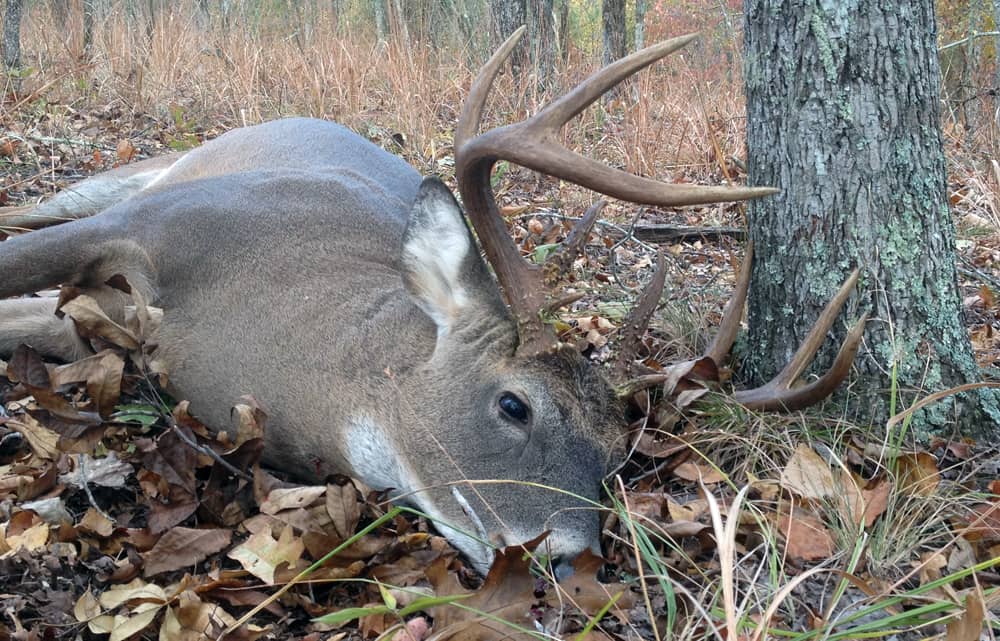A Beginner’s Guide to Field Dressing a Deer
Russ Chastain 11.08.18

As a hunter, I’ve had bloody hands many times — and as I enter my 37th deer hunting season, I don’t know how many deer I’ve field-dressed. It’s not complicated, but it can be daunting if you’ve never done it before. To help you out, here’s a beginner’s guide to field dressing a deer.
First off, you don’t need to field dress every deer. If you will be skinning your deer or delivering it to a processor within a couple hours, you may be ahead to leave the innards in. This will help prevent leaves and sticks from getting into the gut cavity while you transport your critter out of the woods. It will also provide less opportunity for flies to lay eggs.
The first thing to do after finding your deer is to catch your breath and enjoy the moment. You’ve worked hard for this; ride the wave and savor the sensation.
Next, tag your deer or record/report the kill if you’re in an area that requires you to do so. This is usually required before even moving the carcass; don’t neglect it or you could be fined.
Look your deer over to make sure it doesn’t have any previous and/or older wounds. The last thing you want to do is encounter another hunter’s razor-sharp broadhead while reaching into its gut cavity.
Let’s Get Started
Start at the end: use a sharp knife to cut the skin in a circle around the anus, being careful not to cut the intestine. The goal here is to free it up so you can pull the entire intestine through the pelvis from the inside of the deer. Some folks tie it off with a piece of string to keep poop from getting on the deer when you pull it through.
If your deer is a buck, cut the scrotum and testicles off and get rid of them. Cut the penis free so it can be removed from within in the same way as the anus.
Lay the deer on its back if you can. It may help to use snow, a stump, logs, etc to hold it in place while you work.
Starting near the pelvis, cut through the skin and the thin sheet of belly muscle. Take care not to cut the entrails with the tip of your knife; something like the Ultrec Gutting Guide can be useful for that.

(Image: Wikimedia Commons)
The hunter in the photo above stopped his cut at the sternum (base of the ribcage), and that’s an option. If you are going to have the deer mounted, this is a good idea. But you may also choose to cut open the ribcage, which you can do with a decent knife by following the breastbone with your knife, cutting the tips of the ribs free from it while also cutting through meat and hide.
If you’ve gone that far, keep cutting on up along the throat to the base of the skull. While you’re there, sever the windpipe and esophagus at the base of the skull.
Again — if you’re going to have the deer mounted at a taxidermist, DO NOT CUT BEYOND THE REAR OF THE RIBCAGE.
Back at the base of the ribs, cut the diaphragm (sheet of muscle separating the “guts” from the heart/lung area) by following its outer edges with your knife.
This is a good time to roll the animal onto its side and let gravity help you out. Pull out the stomach and intestines, and pull the anus and penis through the pelvis. Take care not to burst the bladder, which is in the area you will be working as you pull them through.
With most of the plumbing out of the way, reach up into the ribcage and remove the heart, lungs, windpipe, and esophagus. This may require a little bit of knife work to free them from connective tissue.
If any poop, stomach contents, or urine got on the meat while field dressing, clean it off immediately.

(Image: Wikimedia Commons)
If you wish to eat the heart and liver, separate them and place into cloth bags. The cloth will allow them to cool while keeping them clean — do NOT place warm fresh organs or other meat into plastic bags without ice.
Take a break, catch your breath, and start carrying your kill out of the woods.
Congrats on your successful hunt! Enjoy the experience, and get back out there soon.

